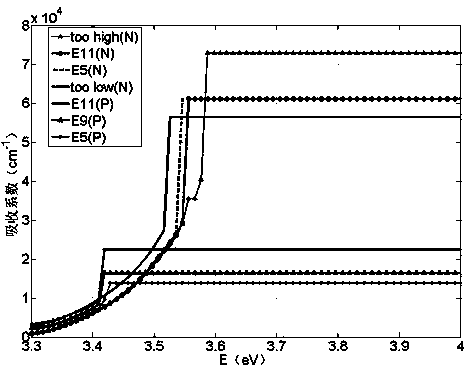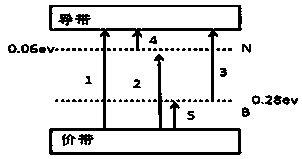A non-destructive determination method for the conductivity type of silicon carbide crystal
A technology of conductivity type and determination method, which is applied in the direction of measuring electricity, measuring electrical variables, testing a single semiconductor device, etc., can solve problems such as inability to obtain conductivity type, inability to determine silicon carbide substrates, inability to evaluate and identify products, etc., to achieve Effects that are easily automated and programmatically controlled
- Summary
- Abstract
- Description
- Claims
- Application Information
AI Technical Summary
Problems solved by technology
Method used
Image
Examples
Embodiment
[0023] Such as figure 1 , 2 As shown, 7 SiC wafer samples with different resistivities and conductivity types are given for testing, and the resistivity measurement adopts the standard COREMA test system, which are ① greater than 1E12 Ω·cm (resistivity system shows too high), ② 1E11Ω ·cm magnitude, ③1E5Ω·cm magnitude, ④less than 1E5Ω·cm magnitude (resistivity system displays toolow), ⑤greater than 1E12 Ω·cm magnitude (resistivity system displays too high), ⑥1E9 Ω·cm magnitude, ⑦1E5Ω·cm level;
[0024] The conductivity type takes the following approach:
[0025] (1) Use a UV-visible-near-infrared spectrophotometer to measure the spectral transmittance of the SiC sample to be tested; the measurement index is absorbance;
[0026] (2) According to the formula (1) given in this patent, the relationship between the absorption coefficient of the silicon carbide sample and the wavelength and its curve can be calculated.
[0027] (3) Obtain the ultraviolet absorption edge position ...
PUM
 Login to View More
Login to View More Abstract
Description
Claims
Application Information
 Login to View More
Login to View More - R&D
- Intellectual Property
- Life Sciences
- Materials
- Tech Scout
- Unparalleled Data Quality
- Higher Quality Content
- 60% Fewer Hallucinations
Browse by: Latest US Patents, China's latest patents, Technical Efficacy Thesaurus, Application Domain, Technology Topic, Popular Technical Reports.
© 2025 PatSnap. All rights reserved.Legal|Privacy policy|Modern Slavery Act Transparency Statement|Sitemap|About US| Contact US: help@patsnap.com


